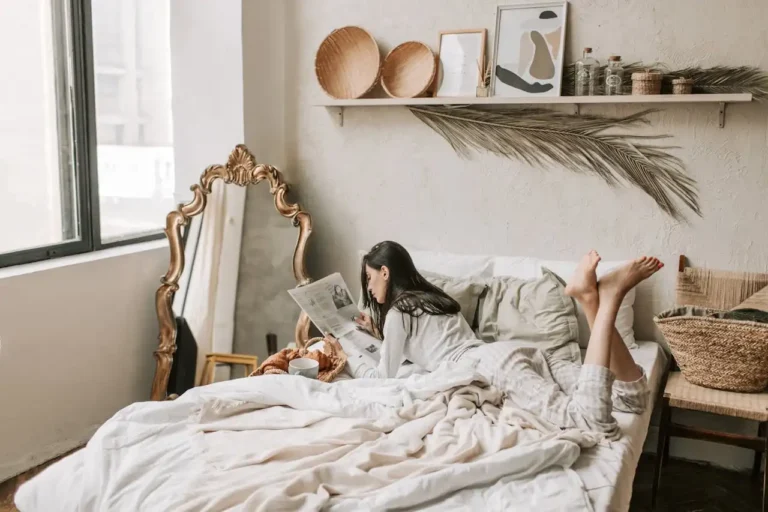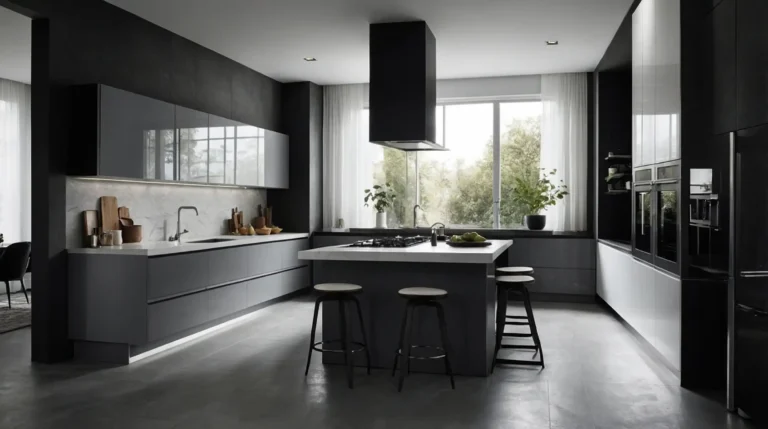27 Stunning Wainscoting Ideas That Transform Ordinary Walls Into Architectural Showpieces
Wainscoting adds instant architectural interest to plain walls, transforming ordinary spaces into custom-looking rooms.
This classic wall treatment creates depth, texture, and character with relatively simple materials.
Beyond aesthetics, wainscoting provides practical benefits—protecting walls from scuffs, adding insulation, and even helping with acoustics.
It works in virtually any room, from formal dining areas to casual mudrooms.
Ready to elevate your home’s interior?
These 27 wainscoting ideas will help you create distinctive spaces that reflect your personal style while adding timeless appeal that increases your home’s value.
1: Classic Board and Batten
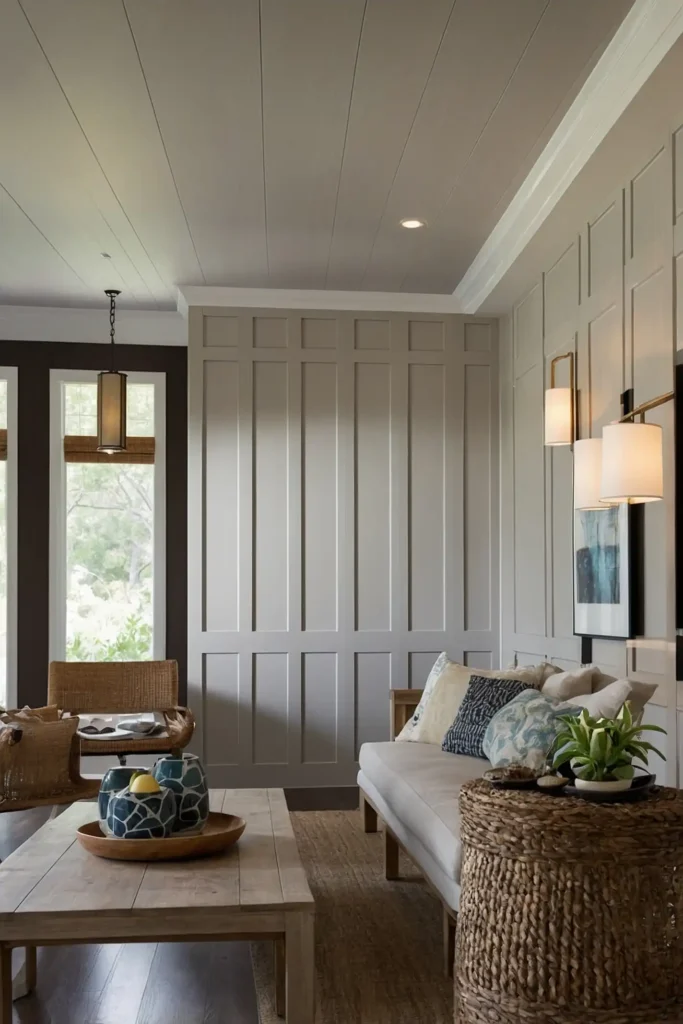
Create architectural interest with vertical boards and horizontal rails that form distinctive rectangular panels.
This versatile style works in both traditional and modern homes.
The clean lines and geometric pattern add dimension without overwhelming the space.
You can customize the height—traditional one-third of the wall or modern two-thirds for greater impact.
This approachable DIY project requires minimal specialized carpentry skills while delivering maximum visual transformation.
2: Elegant Raised Panel

Add formal sophistication with raised panel wainscoting featuring beveled edges that create subtle shadow lines.
This traditional style brings historical elegance to dining rooms and entryways.
The dimensional quality adds depth and texture that flat paint cannot achieve.
The panels create natural framing for furniture placement, enhancing your room’s layout.
This timeless treatment complements traditional furnishings while creating beautiful contrast with more contemporary pieces.
3: Modern Flat Panel
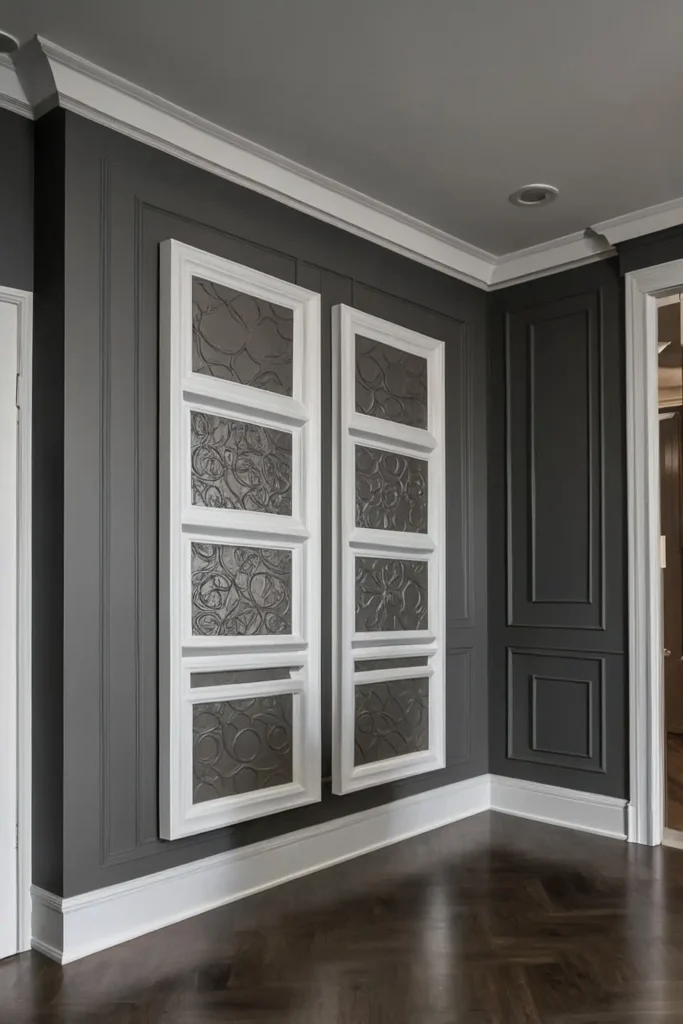
Embrace clean simplicity with flat panel wainscoting that creates geometric interest without ornate details.
This minimalist approach works beautifully in contemporary homes.
The recessed panels create subtle architectural definition without the fussiness of traditional styles.
Paint it the same color as your upper walls for a monochromatic, textural effect.
This versatile style bridges modern and traditional aesthetics, making it perfect for transitional homes.
4: Shiplap Half-Wall
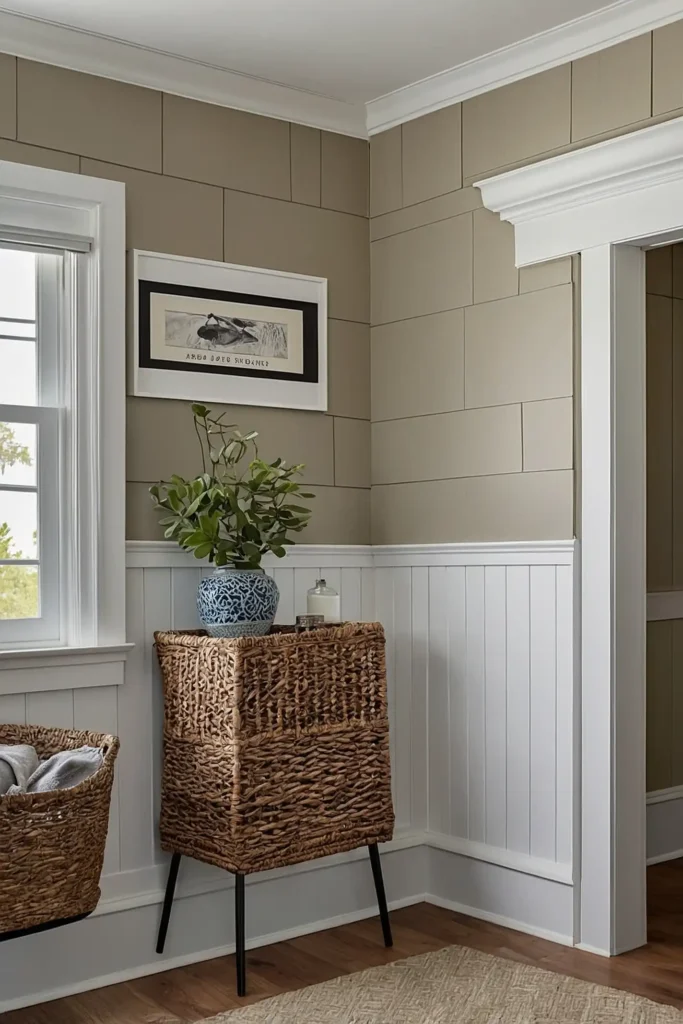
Create casual, coastal charm with horizontal shiplap boards installed to chair-rail height.
This relaxed style adds textural interest with farmhouse appeal.
The distinctive horizontal lines visually widen your space while providing a durable surface in high-traffic areas.
The simple overlapping boards create subtle shadow lines.
This approachable style works particularly well in bathrooms, mudrooms, and casual living spaces.
5: Beadboard Charm
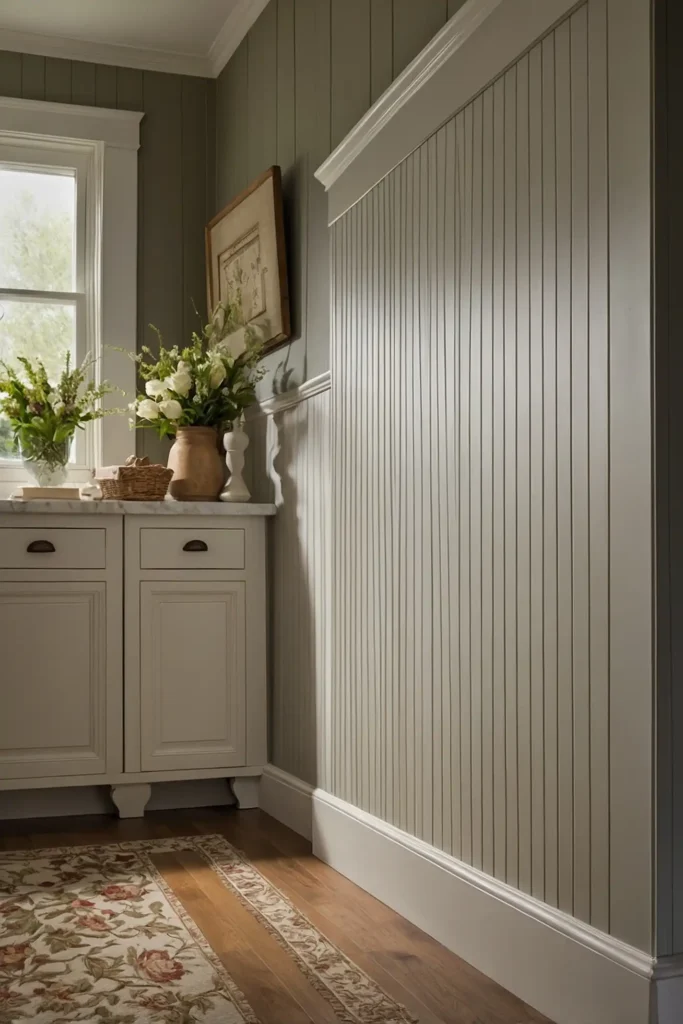
Add cottage character with traditional beadboard featuring distinctive vertical grooves.
This classic style brings nostalgic charm to kitchens, bathrooms, and hallways.
The fine vertical lines create visual height while providing excellent durability against everyday bumps and scuffs.
It excels in hiding wall imperfections in older homes.
This versatile treatment looks equally appropriate in farmhouse, cottage, and traditional settings.
6: Picture Frame Wainscoting
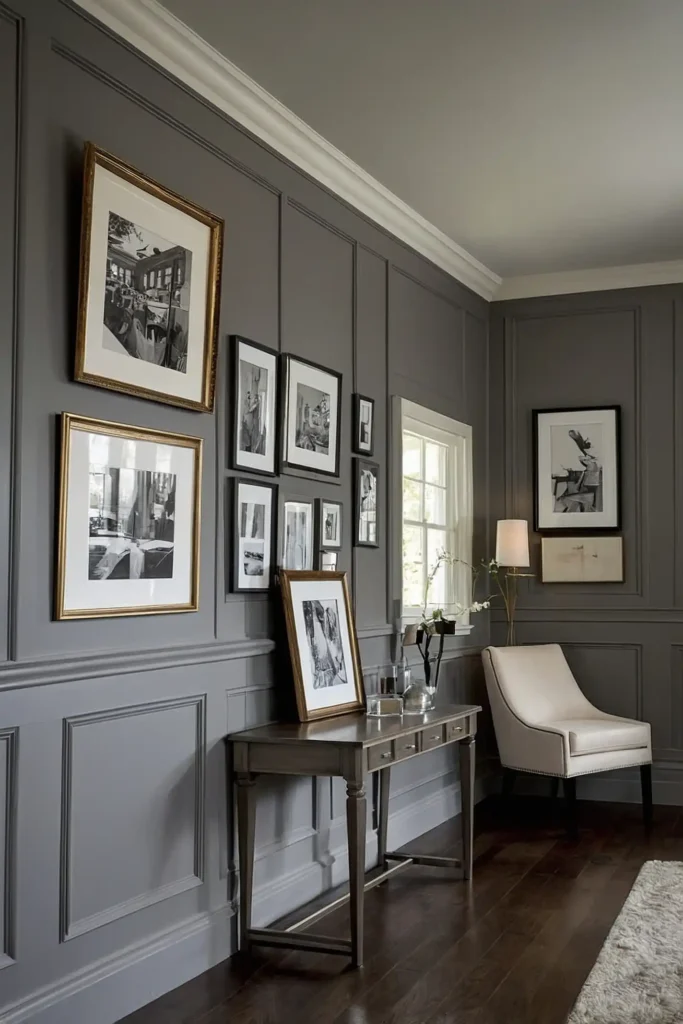
Create elegant dimension with applied molding that forms rectangular frames on your lower walls.
This sophisticated style adds architectural interest without the bulk of true paneling.
The clean geometric shapes create pleasing visual rhythm while requiring less material than full panel systems.
Paint it a contrasting color for dramatic effect or the same color for subtle texture.
This versatile technique works in both traditional and transitional homes, adding character without overwhelming your space.
7: Craftsman-Style Grid

Showcase architectural heritage with distinctive grid patterns featuring vertical stiles and horizontal rails.
This Arts and Crafts-inspired style adds substantial character to living and dining areas.
The geometric arrangement creates visual interest that enhances plain walls while maintaining clean lines.
The sturdy appearance provides visual weight that grounds your space.
This distinctive style pairs beautifully with mission-style furniture and natural wood tones.
8: Modern Slat Wall
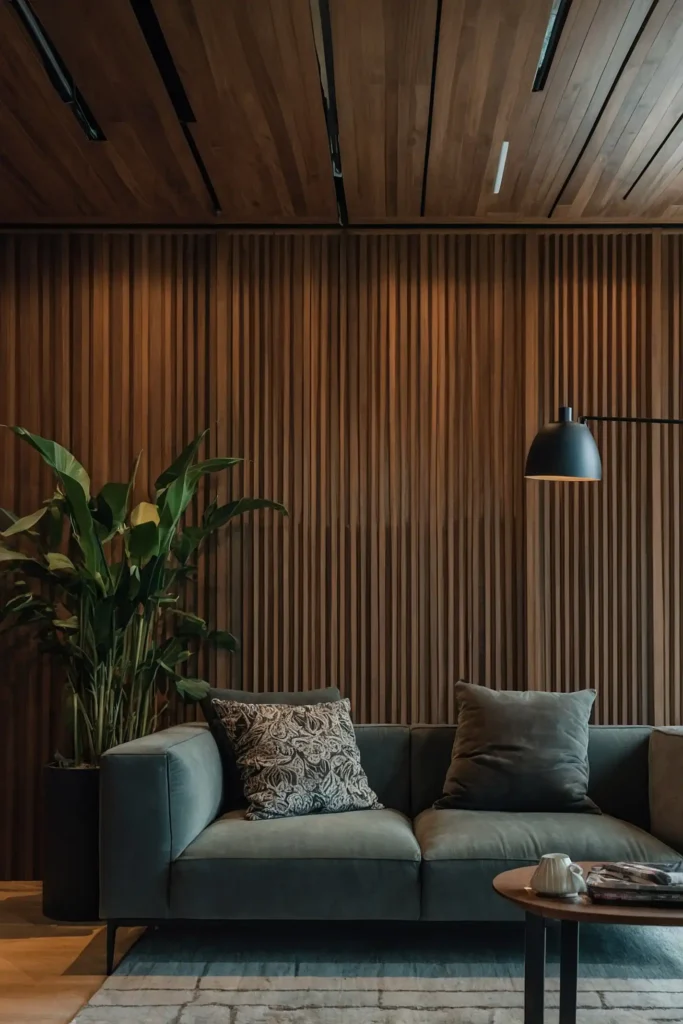
Create contemporary drama with vertical wood slats spaced evenly along your lower wall.
This architectural treatment adds distinctive texture with a modern edge.
The repetitive vertical elements create rhythm and movement while guiding the eye upward, making ceilings appear higher.
The space between slats adds dimensional shadow play.
This statement-making design works particularly well in minimalist spaces and open-concept areas.
9: Two-Tone Color Blocking
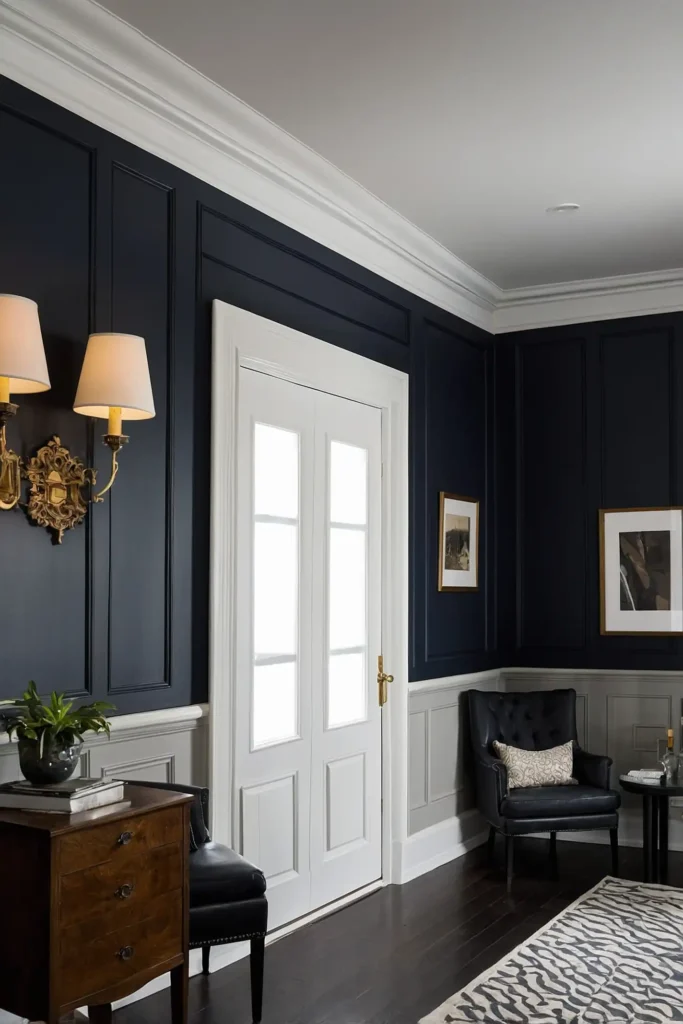
Transform simple wainscoting by painting it a different color than your upper walls.
This high-impact technique creates architectural definition even with basic paneling styles.
Dark lower walls with light uppers create a grounding effect, while light wainscoting against darker upper walls brightens the space.
The horizontal dividing line adds visual interest.
This versatile approach allows you to incorporate bold colors in manageable doses without overwhelming the room.
10: Extra-Tall Wainscoting
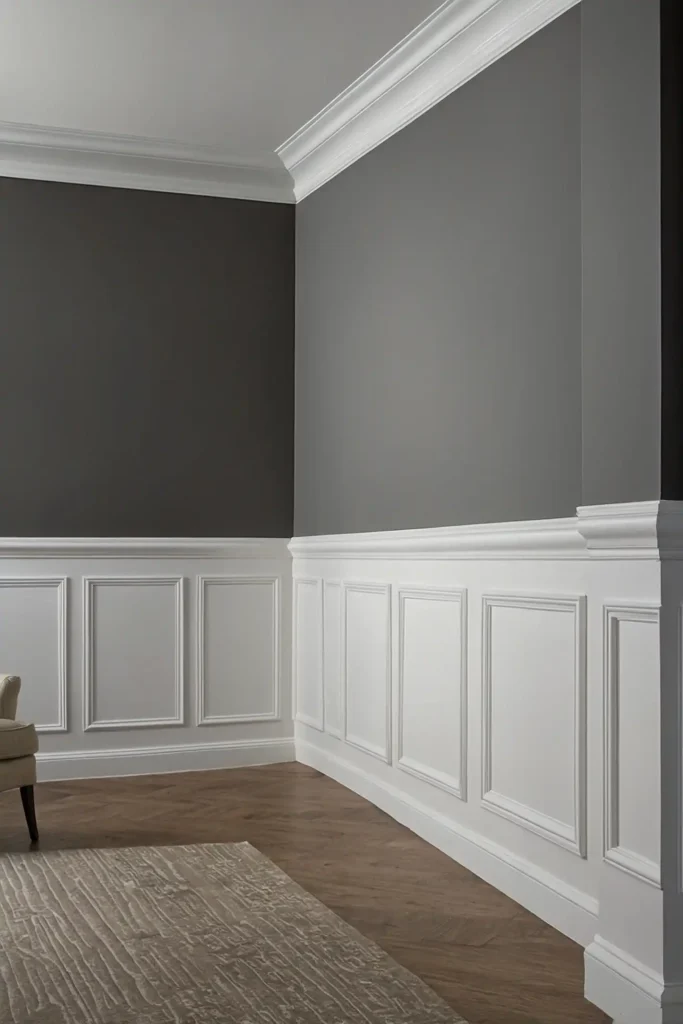
Make a dramatic statement with wainscoting that extends two-thirds up your wall or even to picture-rail height.
This bold approach creates substantial architectural presence.
The extended height establishes a more formal feeling while providing greater wall protection.
It works particularly well in rooms with high ceilings that benefit from visual division.
This impactful treatment creates an instantly custom look that elevates builder-grade spaces.
11: Reclaimed Wood Accent

Add rustic character with wainscoting crafted from reclaimed barn wood or vintage flooring.
This sustainable approach brings history and texture to contemporary spaces.
The weathered patina and varied coloration create visual interest that new materials cannot match.
Each piece tells a story through its unique marks and characteristics.
This distinctive treatment adds warmth and character while creating beautiful contrast with sleeker elements in your room.
12: Painted Beadboard Ceiling
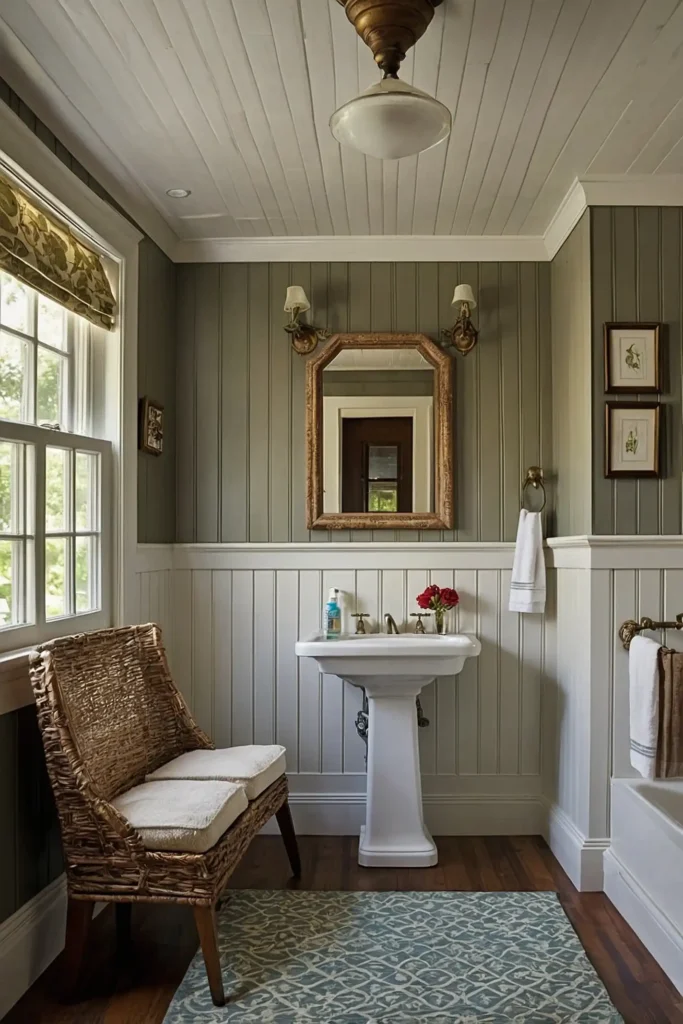
Extend wainscoting upward by installing beadboard on your ceiling. This unexpected application adds charming architectural detail to often-overlooked surfaces.
The distinctive texture creates visual interest overhead while connecting to similar treatments on your walls.
It excels at hiding ceiling imperfections in older homes.
This cottage-inspired treatment works particularly well in bathrooms, porches, and smaller spaces seeking character.
13: Geometric Pattern Accent

Create contemporary drama with geometric-patterned wainscoting featuring chevrons, diamonds, or hexagonal designs.
This modern twist on traditional paneling makes a bold statement.
The unexpected patterns add distinctive personality while maintaining the practical benefits of traditional wainscoting.
Limit it to an accent wall for maximum impact without overwhelm.
This conversation-starting treatment works best in spaces where you want to create a memorable impression.
14: Sophisticated Applied Molding
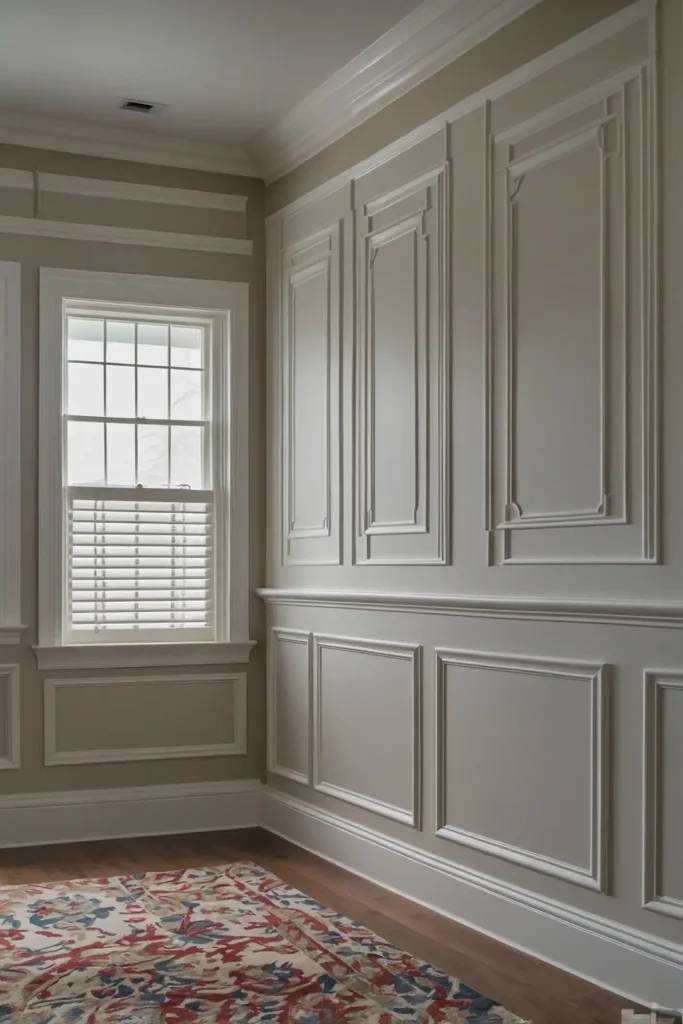
Transform plain walls with decorative molding applied in rectangular or square patterns.
This elegant approach adds architectural interest with minimal material and installation complexity.
The dimensional shadows created by the molding add depth and character to flat surfaces.
The geometric patterns establish pleasing rhythm and proportion throughout the room.
This refined technique brings custom, high-end appeal to dining rooms, living areas, and master bedrooms.
15: Weathered Coastal Boards
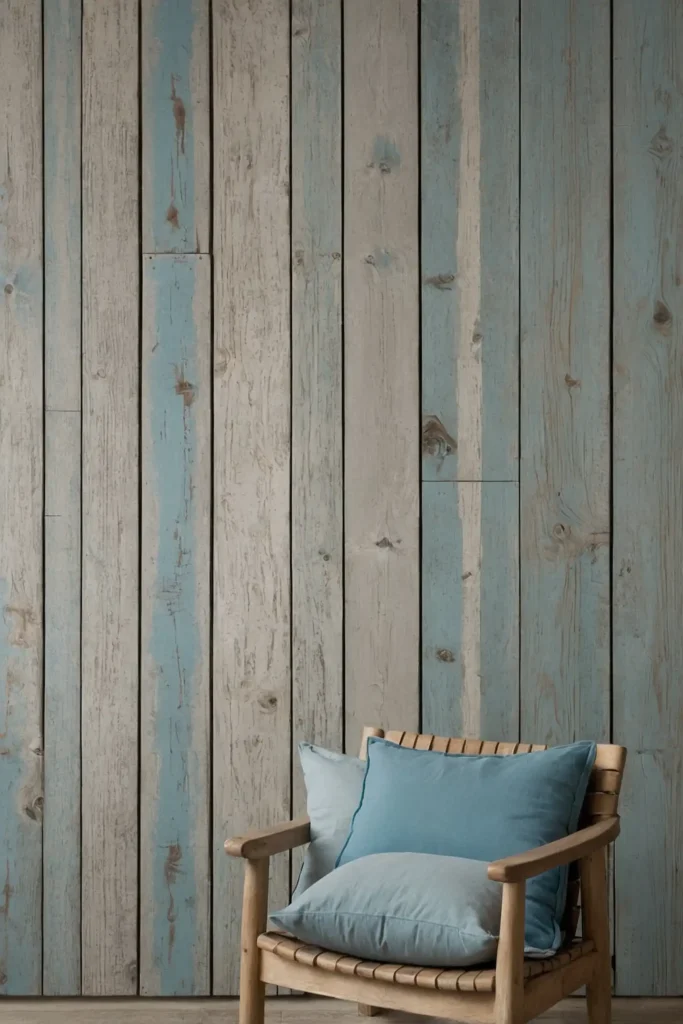
Create relaxed beach house charm with horizontally installed boards in weathered white or soft blue finishes.
This casual style instantly establishes a vacation-home atmosphere.
The horizontal orientation visually expands your space while the distressed finish adds character and forgiveness in high-traffic areas.
It complements natural textures and nautical elements.
This laid-back treatment brings perpetual summer feelings to any room, regardless of your home’s actual location.
16: Classic Chair Rail Divider
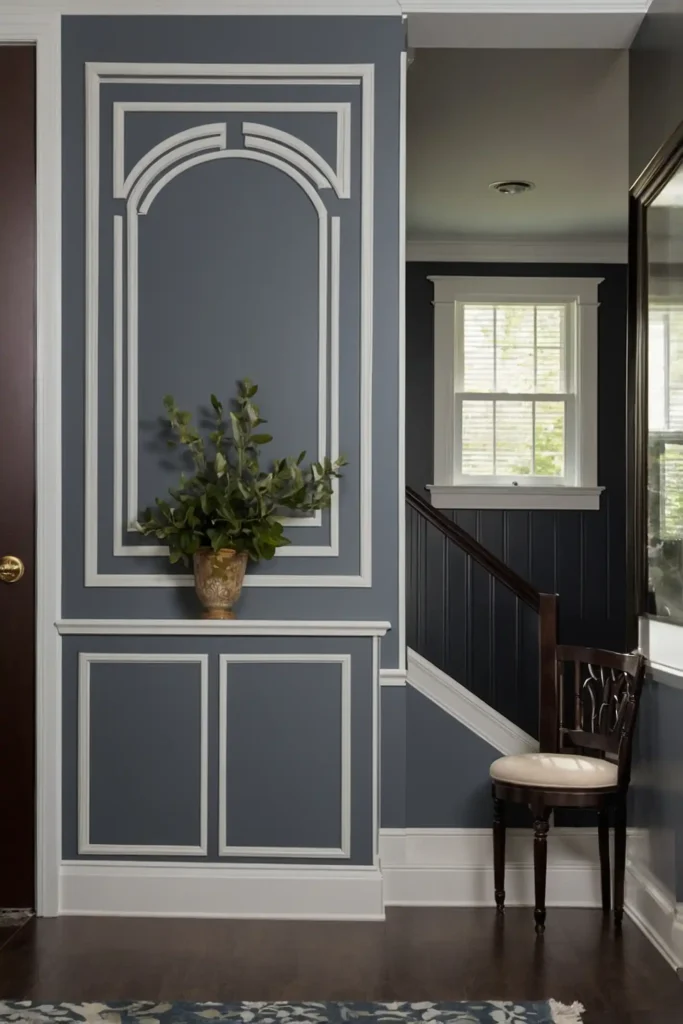
Define your walls with a simple chair rail that creates the effect of wainscoting without full paneling.
This minimalist approach adds architectural definition with minimal materials.
The horizontal line visually divides your wall, creating opportunity for dual paint colors or contrasting wallpaper above.
It provides some wall protection without the fuller coverage of complete wainscoting.
This entry-level option allows you to achieve architectural interest with limited budget and installation complexity.
17: Wallpapered Panel Inserts
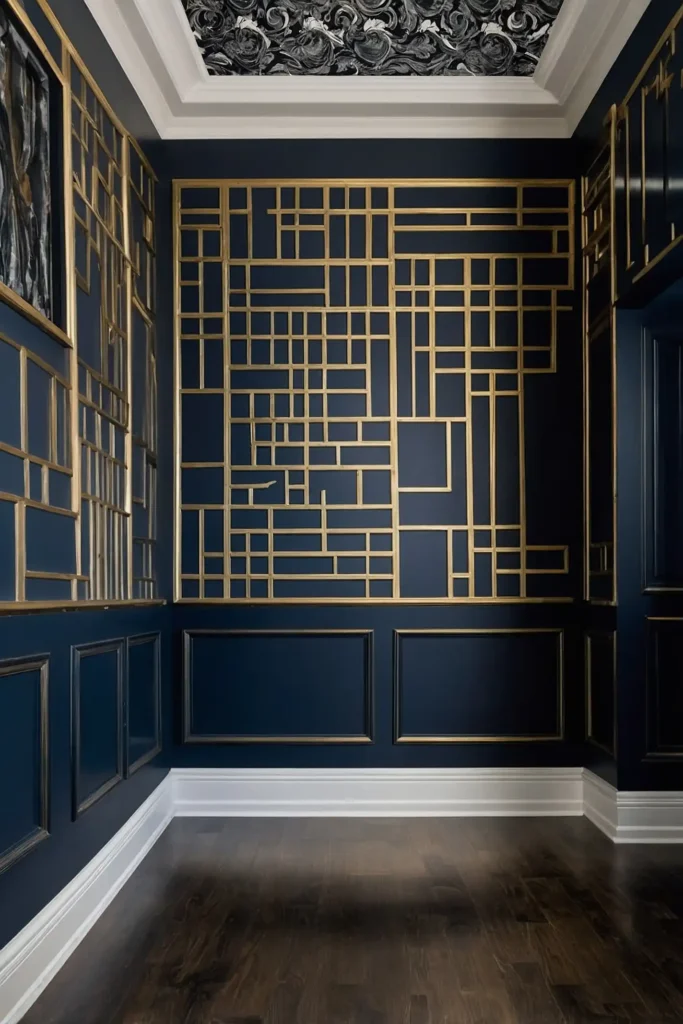
Add unexpected pattern by applying wallpaper within wainscoting frames. This creative approach combines architectural structure with decorative flair.
The panels naturally contain and frame the pattern, allowing you to use bold designs without overwhelming the space.
The surrounding painted framework creates pleasing contrast.
This versatile technique lets you incorporate color and pattern in manageable, updatable doses.
18: Tongue and Groove Vertical Planks
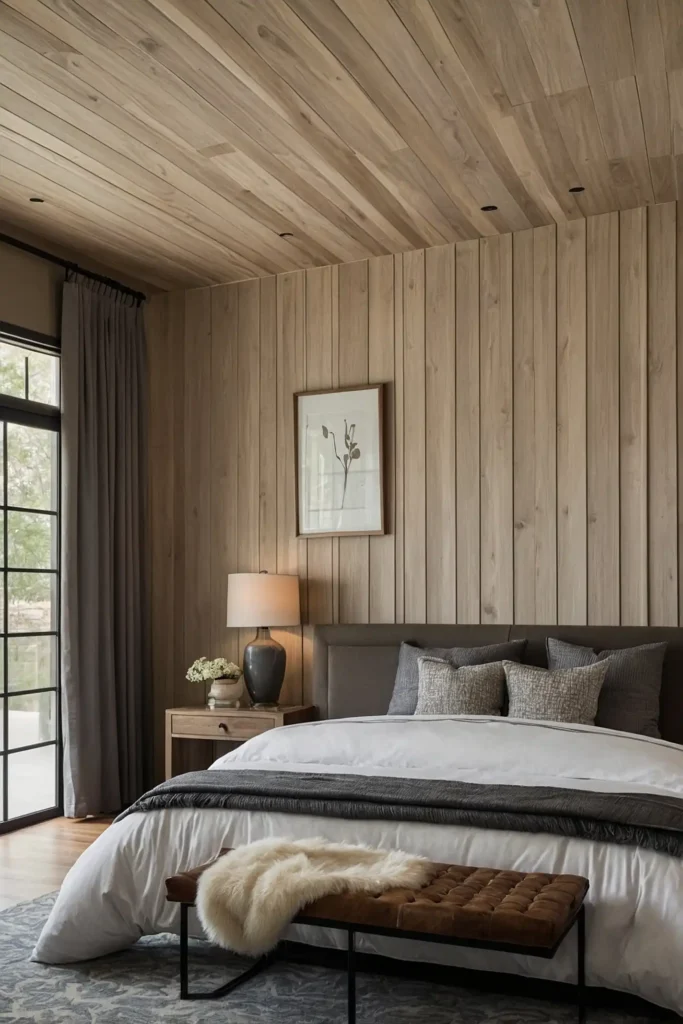
Create rustic-modern appeal with simple tongue and groove boards installed vertically.
This straightforward approach adds linear texture with clean, contemporary lines.
The vertical orientation draws the eye upward, making ceilings appear higher. The subtle seams between boards add just enough texture without appearing busy.
This versatile treatment bridges farmhouse and modern aesthetics, making it perfect for transitional homes.
19: Leather Panel Inserts
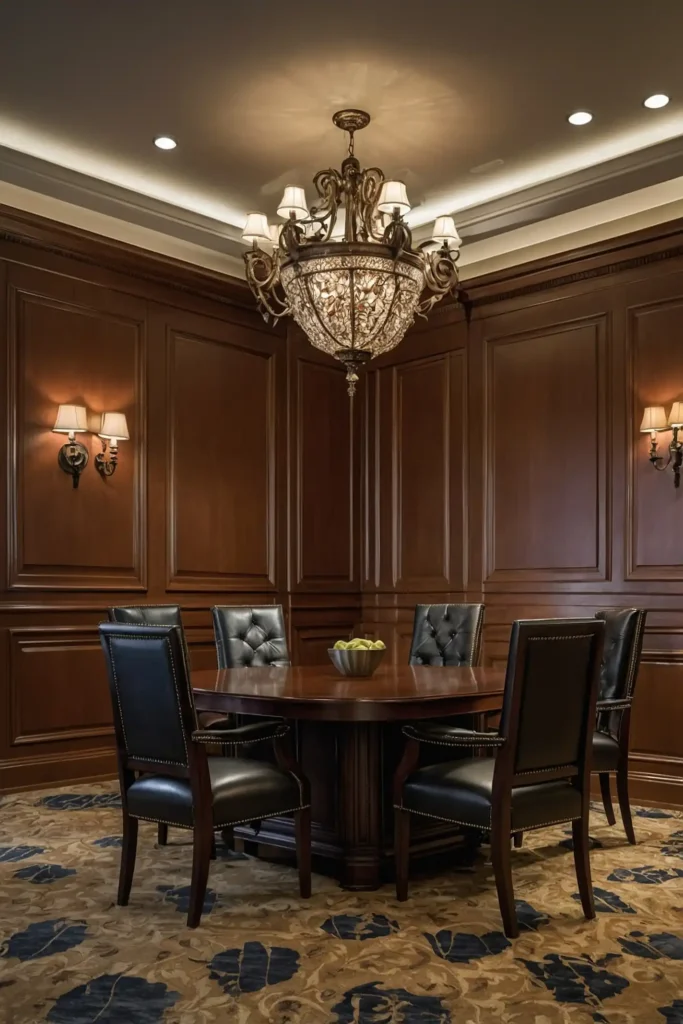
Add unexpected luxury with leather panels installed within traditional wainscoting frames.
This sophisticated approach brings rich texture and warmth to libraries, offices, or dining rooms.
The supple material adds tactile interest that wood alone cannot provide.
The panels absorb sound, improving acoustics in hard-surfaced rooms.
This distinctive treatment creates an instant sense of established elegance with old-world sophistication.
20: Herringbone Pattern Wood
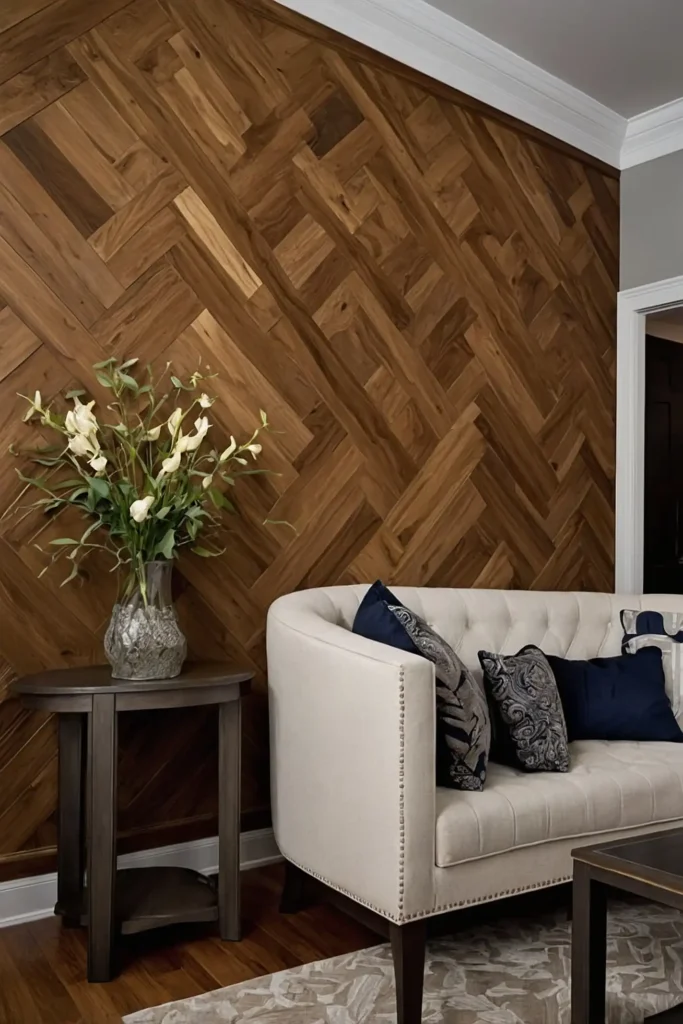
Create visual movement with wood planks installed in a distinctive herringbone pattern.
This dynamic approach adds energy and sophistication to your wainscoting.
The diagonal orientation creates visual interest that standard horizontal or vertical installations lack.
The intricate pattern adds a custom, handcrafted quality.
This statement-making treatment works well in dining rooms, entryways, or anywhere you want to create a memorable impression.
21: Upholstered Panel Sections
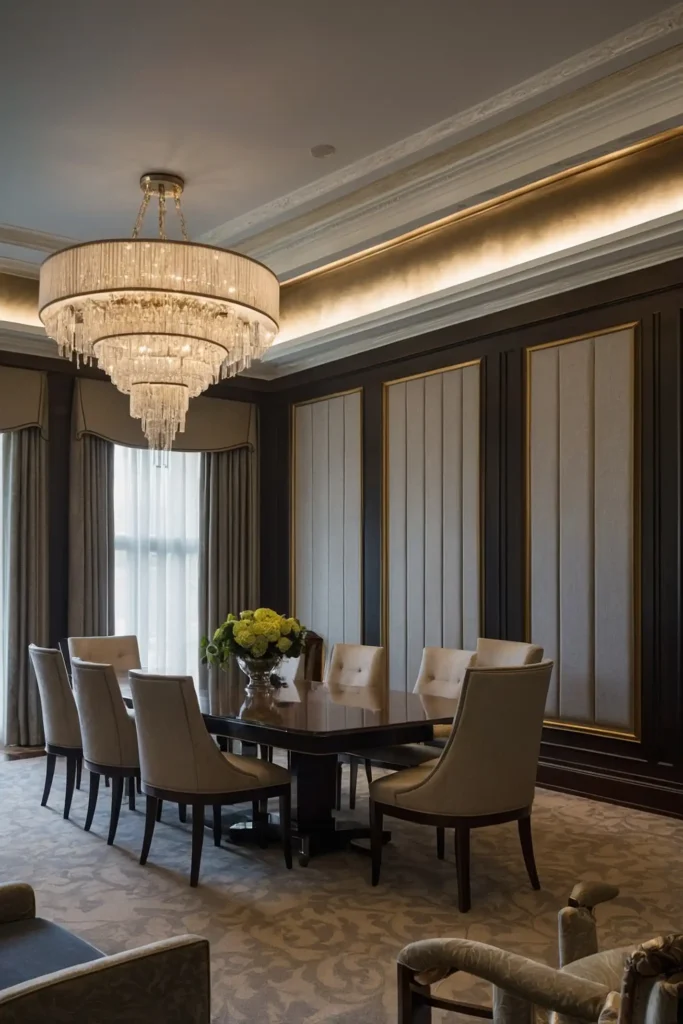
Add unexpected comfort with fabric-upholstered panels within your wainscoting framework.
This luxurious approach brings textile softness to hard-surfaced walls.
The padded panels improve room acoustics while adding tactile dimension.
Choose performance fabrics for high-traffic areas or velvet for luxurious formal spaces.
This distinctive treatment works particularly well in dining rooms, bedrooms, or media spaces where sound absorption benefits function.
22: Natural Wood Tone Finish
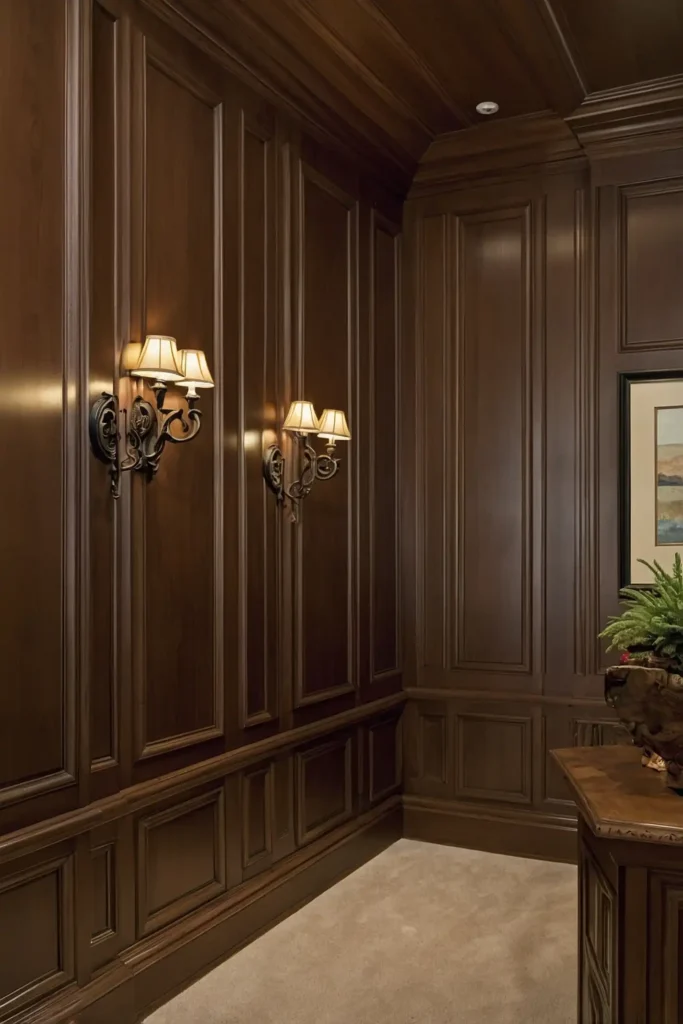
Celebrate wood’s inherent beauty by finishing your wainscoting with clear sealers rather than paint.
This approach adds warmth and organic texture to your space.
The natural grain patterns create visual interest that painted surfaces cannot match.
Different wood species offer various color tones from honey pine to rich walnut.
This timeless treatment adds warmth to spaces that might otherwise feel too cool or sterile.
23: Vertical Shiplap Variation

Create contemporary height with vertically installed shiplap boards.
This modern twist on a classic material draws the eye upward, making ceilings appear higher.
The distinctive shadow lines between boards add subtle texture without overwhelming pattern.
The vertical orientation creates a more formal, elegant effect than horizontal installations.
This versatile treatment works well in transitional spaces that blend traditional materials with contemporary applications.
24: Integrated Shelf Ledge
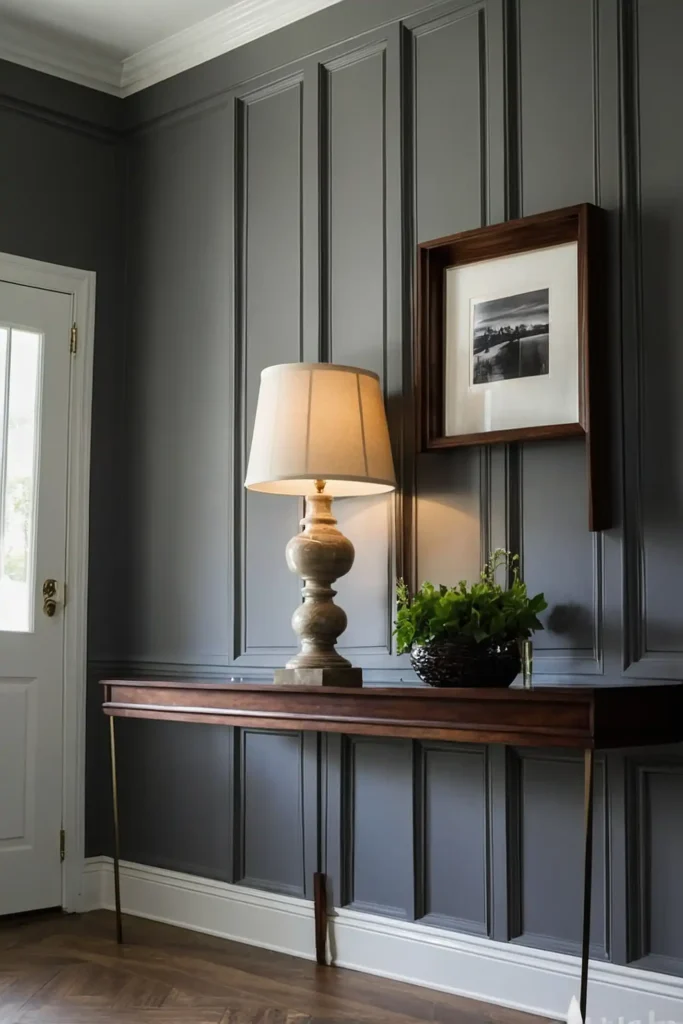
Add functionality by incorporating a narrow shelf at the top of your wainscoting.
This practical approach creates display space for art, photos, or decorative objects.
The horizontal ledge adds architectural interest while providing practical utility.
It works particularly well in hallways, dining rooms, or living areas where display space enhances your décor.
This multifunctional treatment combines form and function in one elegant installation.
25: Curved Panel Details

Add sophisticated elegance with wainscoting panels featuring arched or curved top edges.
This refined detail elevates standard rectangular panels to custom artistry.
The gentle curves add softness and movement to what might otherwise be rigid geometry.
This subtle detail signals intentional design choices and attention to craftsmanship.
This distinctive treatment works particularly well in formal spaces like dining rooms, living rooms, or master suites.
26: Patterned Paint Technique
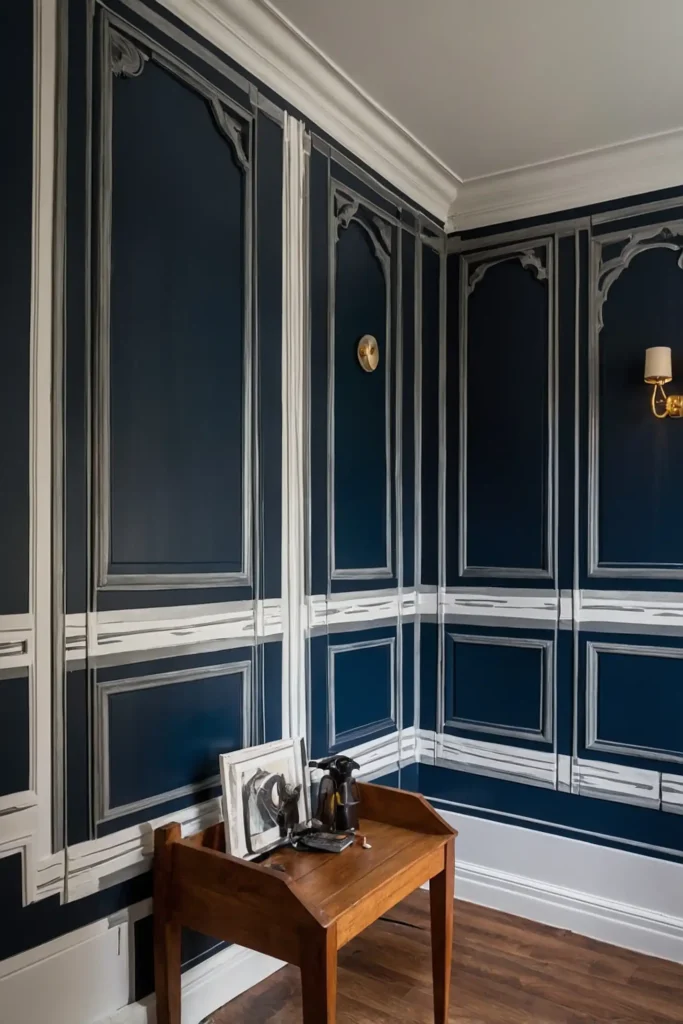
Create the illusion of paneling using paint and precise taping to form geometric patterns. This budget-friendly approach adds architectural interest without carpentry.
The contrasting colors create visual dimension that mimics physical paneling.
This technique requires only paint and patience rather than carpentry skills.
This accessible treatment allows you to experiment with wainscoting effects before committing to permanent installation.
27: Mixed Material Combination
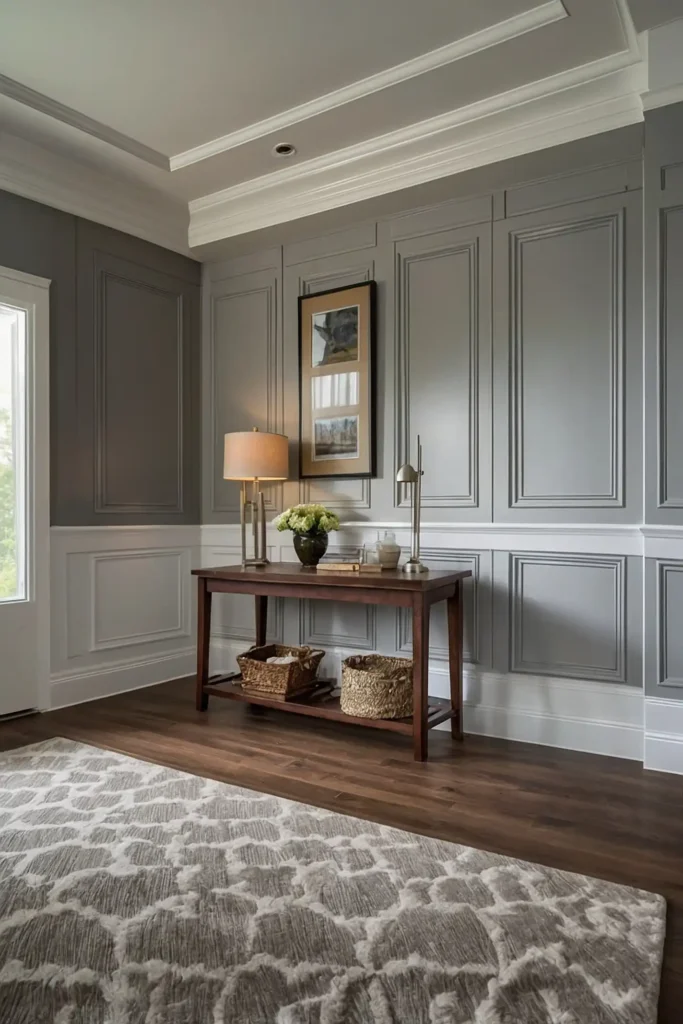
Create distinctive texture by combining different wainscoting styles within the same room.
This designer approach might pair beadboard with raised panels or shiplap with flat frames.
The varied textures create visual interest while maintaining cohesion through consistent height and paint color.
This technique adds sophisticated complexity to your architectural detailing.
This advanced approach creates truly custom spaces that showcase intentional design decisions beyond standard installations.
Conclusion
Wainscoting transforms ordinary walls into architectural features that define your home’s character.
Whether simple or elaborate, these panel designs add lasting value, protection, and distinctive style to any room in your house.



